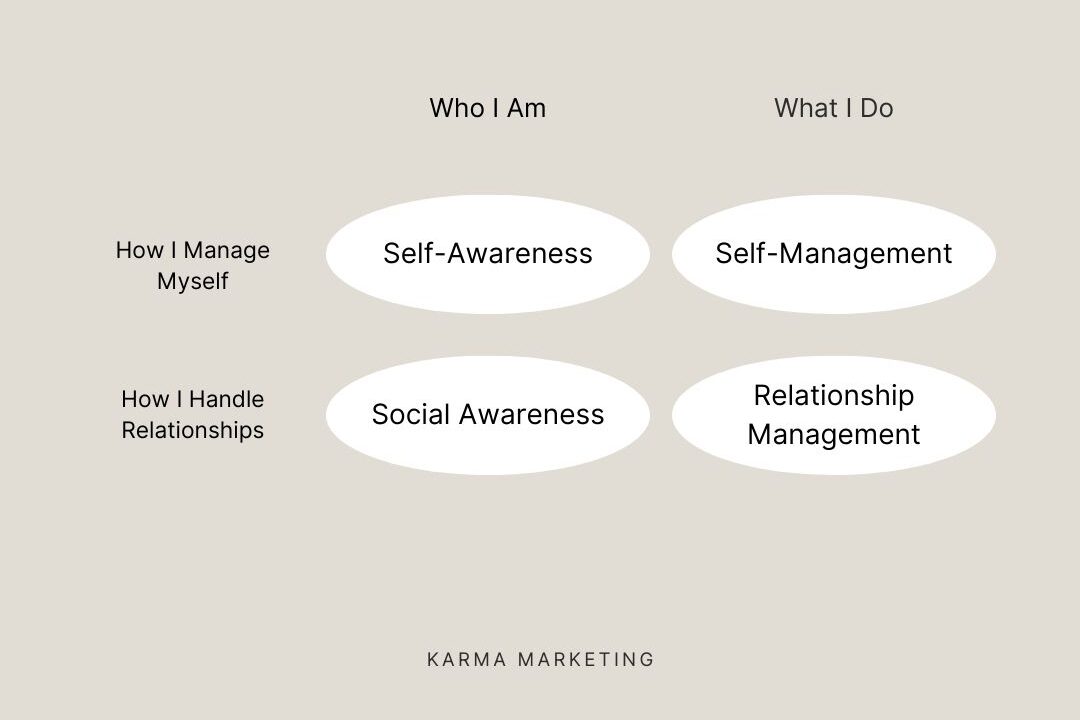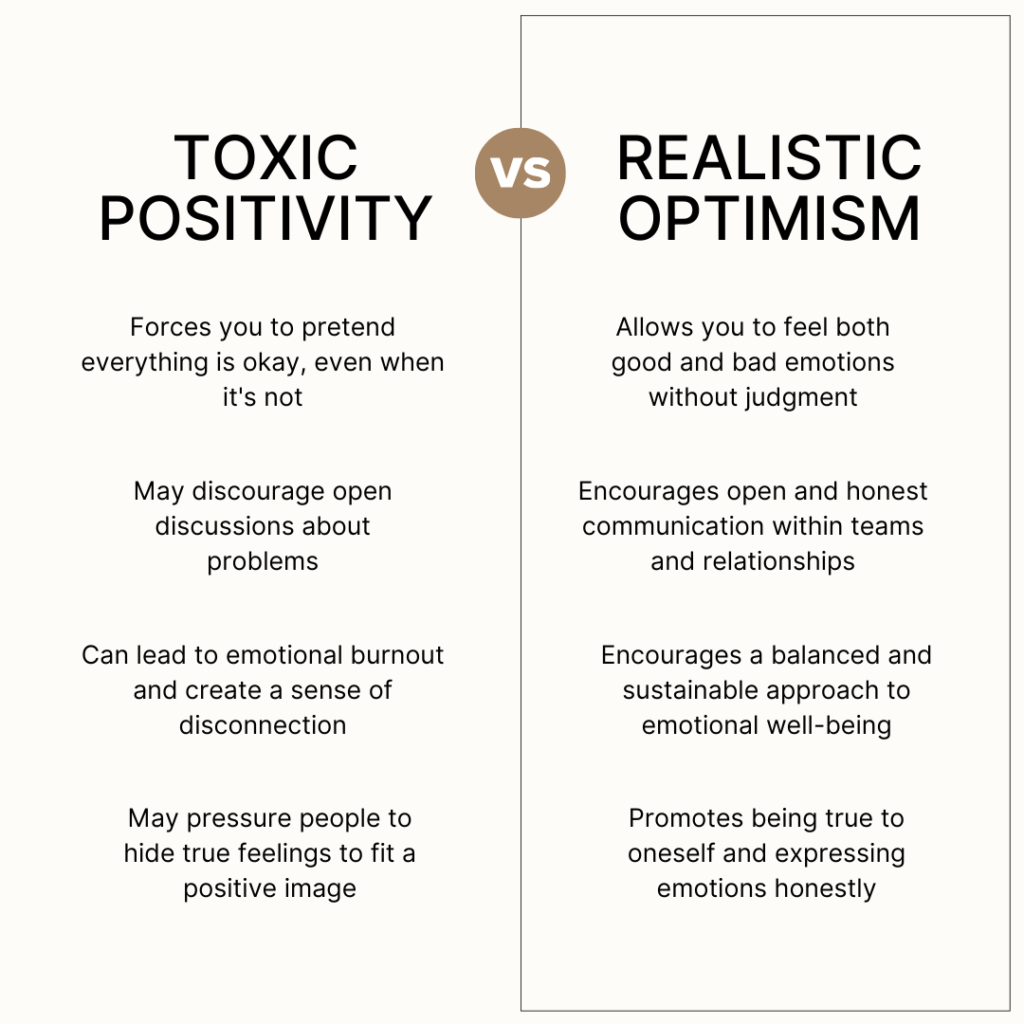Embracing Positivity While Staying Grounded in Reality
It’s true that happy employees are more likely to achieve their goals, as a study from the Saïd Business School at the University of Oxford suggests. In a world where the pursuit of happiness often takes center stage, it’s easy to fall into the trap of relentless positivity, believing that everything will magically fall into place if we just keep a sunny outlook. However, while optimism can undoubtedly uplift us, there’s a fine line between genuine positivity and blind idealism. True emotional awareness requires a balanced approach that acknowledges both the highs and lows of life. In this article, we explore the concept of “Realistic Positivity” – a powerful blueprint for nurturing emotional intelligence and self-awareness.
Emotions in The Workplace
We often prioritize focusing on the most effective ways to work, emphasizing objective aspects that are easily measurable. Our attention revolves around finding the optimal work culture for the team, enabling us to reach targets efficiently and satisfying clients. We believe that our professionalism lies in how we handle tasks.
While this perspective holds truth, it’s essential to recognize that managing emotions plays a vital role in fostering good work behavior. In the workplace context, emotions refer to our reactions to various situations and events that happen at work. These reactions can be positive or negative, and they significantly influence our work performance, relationships with colleagues, and overall well-being.
For example, if we are feeling happy and motivated, we are more likely to be productive and engaged in our work. On the other hand, if we are feeling stressed or anxious, we may be more likely to make mistakes or have difficulty interacting with others.
Studies have shown that employees with high EQ are more likely to be promoted and achieve higher levels of performance. This is because they are better able to manage their emotions, build relationships, and resolve conflict. Other studies show that they are also more likely to be clear and concise in their communication, and they are more likely to be able to listen to and understand the perspectives of others.
Exploring The EQ Quadrants
Emotional intelligence extends beyond self-awareness and self-management; it encompasses how we handle our interactions with others. It involves not only understanding ourselves but also effectively managing our relationships with those around us.
Emotional intelligence reflects in our actions as well as our thoughts, as we navigate and nurture positive connections with the people we interact with.
To simplify the concept, Daniel Goleman, in his book “Emotional Intelligence: Why It Can Matter More Than IQ,” introduces a model known as the EQ Quadrants. This framework helps to grasp the idea more easily.


Emotional Intelligence is the ability to recognize, understand, manage, and use emotions effectively in various aspects of life. The four components of the EQ Quadrants are:
- Self-awareness: This is the foundation of emotional intelligence. It involves being aware of your own emotions, strengths, weaknesses, values, and the impact you have on others. Self-aware individuals can accurately recognize their feelings as they arise and understand the reasons behind them. They are also mindful of how their emotions affect their thoughts and actions.
- Example: A person with high self-awareness knows when they are feeling stressed or anxious and can pinpoint the specific triggers causing those emotions.
- Self-management: Once you are aware of your emotions, the next step is managing them effectively. This component involves the ability to control impulsive behaviors, adapt to changing circumstances, and positively handle stress and challenges. Self-management allows you to channel your emotions in constructive directions.
- Example: Instead of reacting angrily to criticism, a person with strong self-management skills will take a deep breath, remain composed, and respond calmly to the feedback.
- Social awareness: This component revolves around understanding and empathizing with the emotions of others. It involves paying attention to verbal and nonverbal cues to pick up on how people feel, what they need, and how to relate to them effectively. Socially aware individuals are good listeners and make others feel valued and understood.
- Example: Someone with high social awareness can sense when a friend is feeling down even if they don’t explicitly say so, and they provide support and empathy.
- Relationship management: This component focuses on using your self-awareness, self-management, and social awareness to build and maintain healthy, positive relationships with others. Effective relationship management involves communication, conflict resolution, collaboration, and the ability to influence and inspire others.
- Example: An individual with strong relationship management skills can mediate conflicts between team members, build consensus, and foster a cooperative work environment.
Now that we understand how emotional intelligence involves both managing relationships and being self-aware, let’s delve into how we perceive emotions themselves.
Emotions are not obstacles or distractions; they are natural expressions of being human. Acknowledging this range of emotions allows us to grow wiser. Therefore, avoiding emotions in the workplace isn’t necessary; instead, learning how to manage them effectively is the focus of the next part of this article.
Why Leaders Must Master Emotional Awareness
Have you ever experienced a coworker who was stressed and anxious about an ongoing project? How did witnessing their state make you feel? Did it contribute to a tense and stressful environment? Did it make it challenging for you to stay focused and optimistic?
Emotional contagion is the process by which people catch the emotions of others. This can happen through facial expressions, body language, tone of voice, and even words. When leaders are in a good mood, their team members are more likely to be in a good mood as well. This is because people are naturally drawn to positive emotions and tend to mirror the emotions of those around them.
On the other hand, when leaders are in a bad mood, their team members are more likely to be in a bad mood as well. This can lead to decreased productivity, increased conflict, and a decline in morale.
For this reason, it is important for leaders to be aware of their own emotional state and to manage their emotions in a way that is beneficial to their team. This means being mindful of their facial expressions, body language, and tone of voice. It also means being careful about what they say and how they say it.
Of course, leaders are human beings and they are going to have negative emotions from time to time. However, it is important for them to deal with these emotions in a healthy way.
Balancing Expectations and Reality
As leaders, we often aim to maintain a positive attitude because we understand how our emotions can influence the entire team. We want to create a good environment where our employees can work without feeling stressed.
The foundation of emotional awareness lies in recognizing that life is a blend of various emotions. It’s not just about feeling good or bad, as emotions span a whole spectrum of colors. We shouldn’t dismiss negative emotions simply because they are labeled as “negative.” Each emotion exists within us for a reason, and understanding this is crucial.
When a specific project triggers anxiety, it’s essential to explore the reasons behind it. Is the entire team feeling the same way? To move the project forward smoothly, we need to address the collective emotion.
While some might believe that concerns about the future are a hindrance and should be suppressed to maintain professionalism, it’s actually wiser to openly discuss how we can proactively prevent such concerns or strategize for handling worst-case scenarios.

Afterthought
Emotional intelligence goes beyond mere self-soothing and maintaining a perpetually positive attitude. True emotional intelligence entails confronting negativity and discomfort with maturity rather than blindly pursuing relentless optimism.
Realistic optimism presents a balanced approach to professional life as well as personal life. Embracing a positive mindset while staying grounded in reality allows us to navigate life’s challenges with resilience. Realistic optimists understand that challenges are a natural part of life, and they use them as opportunities for growth and learning.
Karma Wisdom | Curated research written by Anya Junor
